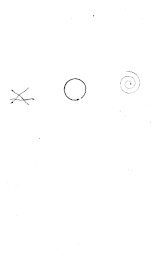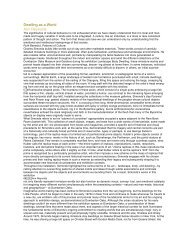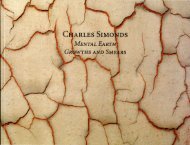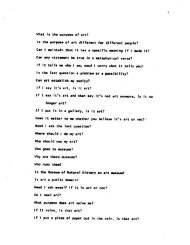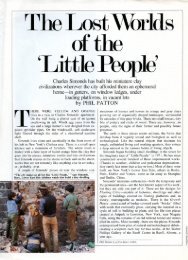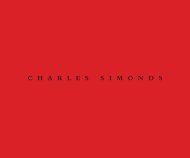Read Catalog - Charles Simonds
Read Catalog - Charles Simonds
Read Catalog - Charles Simonds
You also want an ePaper? Increase the reach of your titles
YUMPU automatically turns print PDFs into web optimized ePapers that Google loves.
the question, just as formal analysis alone can only inadequately account for<br />
what we feel his landscapes and architectures actually mean. The genesis of<br />
Circles and Towers Growing (pls. 32-43), although more complicated than<br />
most, reflects <strong>Charles</strong> <strong>Simonds</strong>'s working methods for his art as a whole, the<br />
objects as well as the underlying ideas.<br />
One can make the case that each of his pieces, whatever its size, in itself implies<br />
the entirety; that each part of the sequence (an open-ended, expanding<br />
class as opposed to the closed grouping of a series) 5 deals only with the same<br />
work in a different moment. The elaboration of the idea into various landscapes,<br />
and new kinds and combinations of structures, enriches our understanding<br />
but is, strictly speaking, conceptually unnecessary. Each additional<br />
piece, however, adds to the possibility of new audiences and variations<br />
through which one might be better able to enter into <strong>Simonds</strong>'s art. As <strong>Simonds</strong><br />
said regarding Circles and Towers Growing, "Nothing but time prevents<br />
me from going back to fill in all the betweens. Even in a microsecond there<br />
are thousands of ideas for different states between the 12 actual works." 6 In<br />
fact, the cycle can be read as several cycles reading at different speeds, laterally<br />
as well as in linear branches (see below, Circles and Towers Growing,<br />
Commentaries). Given the circumstances of its making, this should not be<br />
surprising.<br />
The cycle came into being at a time when <strong>Simonds</strong> was in a position to consolidate<br />
a busy year of work While in Berlin in 1978, taking part in the international<br />
artist-in-residency program known as DAAD (Deutscher Akademischen<br />
Austauschdienstes), <strong>Simonds</strong> built nine of the cycle almost entirely in<br />
numerical order, the Circles (Numbers r-s}, then the Towers {Numbers 7-Ioj.<br />
The final two Towers (Numbers I I and r2) were built in the fall of 1978<br />
when <strong>Simonds</strong> returned to his underground studio at 152 Wooster Street, New<br />
York. The cycle was completed by the addition of another Circle (Number<br />
6), which <strong>Simonds</strong> literally removed from his room-sized 1976 installation<br />
Picaresque Landscape (cover ill.), then stored in 23 sections in an adjoining<br />
room. This piece was itself a variant of an earlier portable object, the important<br />
1972 People Who Live in a Circle (pl. 14). <strong>Simonds</strong> decided simply to use<br />
the variant once again rather than build a third version. 7 These three "New<br />
York" pieces were then sent together to Germany to join the nine "Berlin"<br />
works to unite the cycle physically for the first time.<br />
The clay for the nine pieces made in Germany came from the recycled<br />
" " installation which had filled a medium-sized upper gallery in the<br />
Museum Fridericianum in Kassel during "Documenta 6" in 1977 (pl. 21).<br />
Colors ran the spectrum-black, gray-green, red, yellow-orange, yellow, and<br />
pink. At the conclusion of the summer-long exhibition, the landscape and<br />
its intricate structures were reduced to raw clay and shipped to the artist in<br />
Berlin. In addition to the multicolored clays frmn near Kassel there is also<br />
in the Circles and Towers Growing a yellow clay from Berlin and the red and<br />
gray clay from <strong>Simonds</strong>'s primary source in Sayreville, New Jersey. The sand<br />
also came from near Kassel and the various sticks, chicken bones, shells,<br />
pebbles, or other materials from friends (who are always on the lookout for<br />
tiny specimens of all sorts) and the artist's own far-flung travels.<br />
I3



